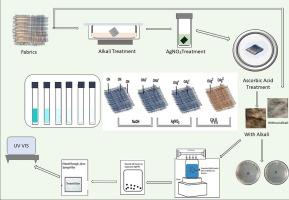Developments of antibacterial textiles with functionality of hazardous pollutant degradation
Abstract
Global economy is inching towards the reduction of waste which is a major concern for the industries worldwide. This study revealed the surface modified Cotton and Flax fabrics via Silver Nanoparticles for the degradation of organic pollutant found in industry wastewater. In situ synthesis was used for development of Ag-treated cotton and flax fabrics using ascorbic acid as a reducing agent through dipping into the silver nitrate solution prepared by chemical reduction. Treated fabrics were characterized by a Fourier Transform Scanning Electron Microscope, Energy-dispersive X-ray spectroscopy, X-ray diffraction analysis, X-ray photoelectron spectroscopy, Thermogravimetric analysis, and also an Anti-microbial test. The SEM study revealed a good presence of AgNPs with average particle sizes of silver being 53.5 nm and 132.75 nm for silver treated Cotton and Flax fabrics respectively. Analysis of weight loss behavior showed lower thermal consistency for Fx-Alk-Ag fabric rather than Co-Alk-Ag. The bacterial resistance against E.coli recorded by ZOI value for Co-Alk-Ag and Fx-Alk-Ag were 12 mm and 10 mm respectively. The alkali treated fabrics exhibited as adsorbents and also operated as photocatalysts for degradation of organic pollutants from aqueous medium. The Co-Alk-Ag and Fx-Alk-Ag adsorbents explored an outstanding degradation performance of MB with 90.45 % and 99.37 % within 60 min without using any reducing agent. Prominent adsorption phenomena have been noticed in Flax fabrics than in the Cotton fabrics. Linear fittings and R2 values gave conclusive evidence on Langmuir model to be better suited for isotherm phenomenon in the treated fabrics than the Freundlich model. The adsorption phenomenon was evaluated using the Intraparticle Diffusion model where quick adsorption and continuous slow diffusion were found responsible for dye removal. According to these research results, Co-Alk-Ag and Fx-Alk-Ag would have a great opportunity in the degradation of textile pollutants as well as the antimicrobial properties of these composites.


 求助内容:
求助内容: 应助结果提醒方式:
应助结果提醒方式:


